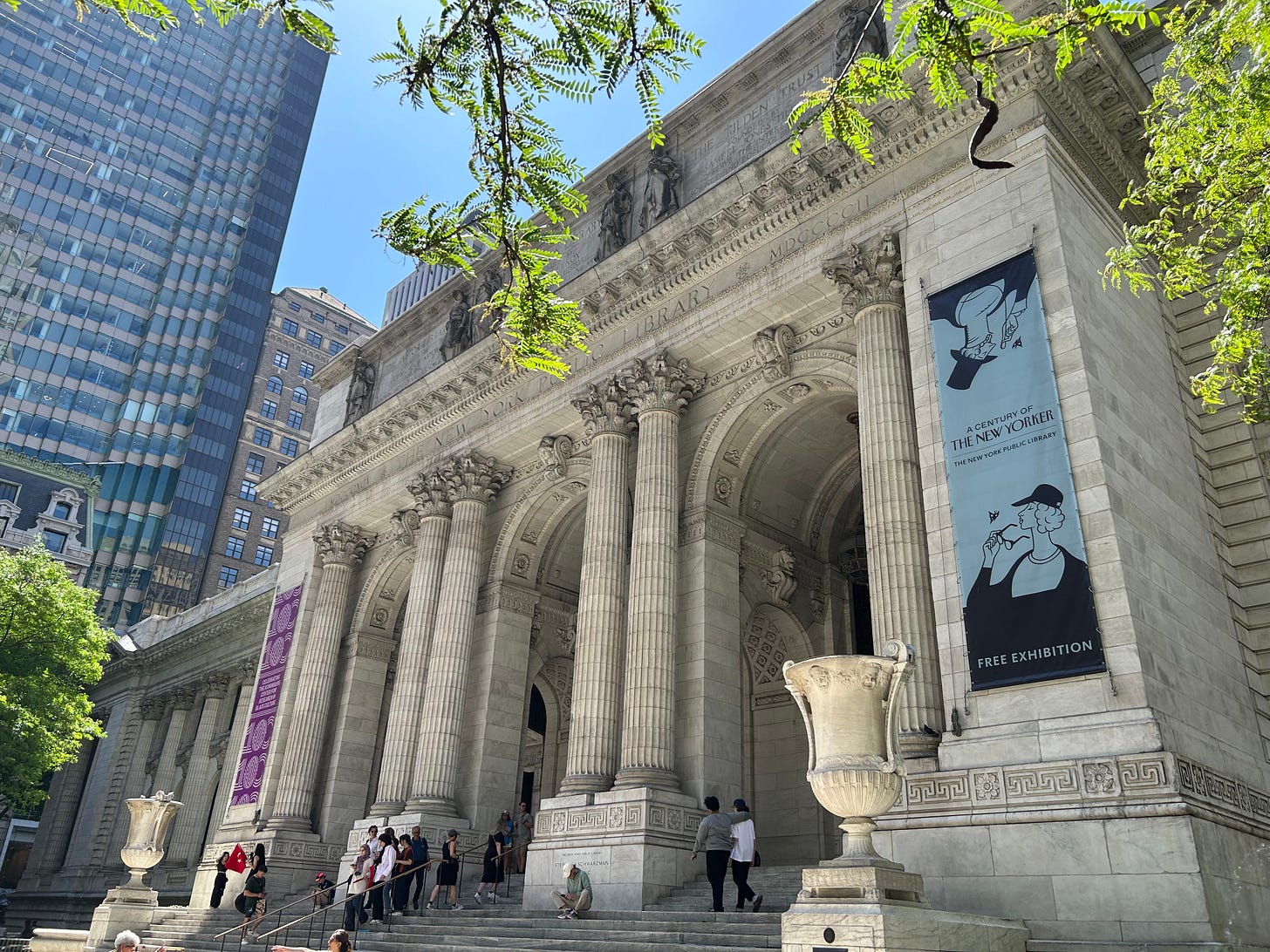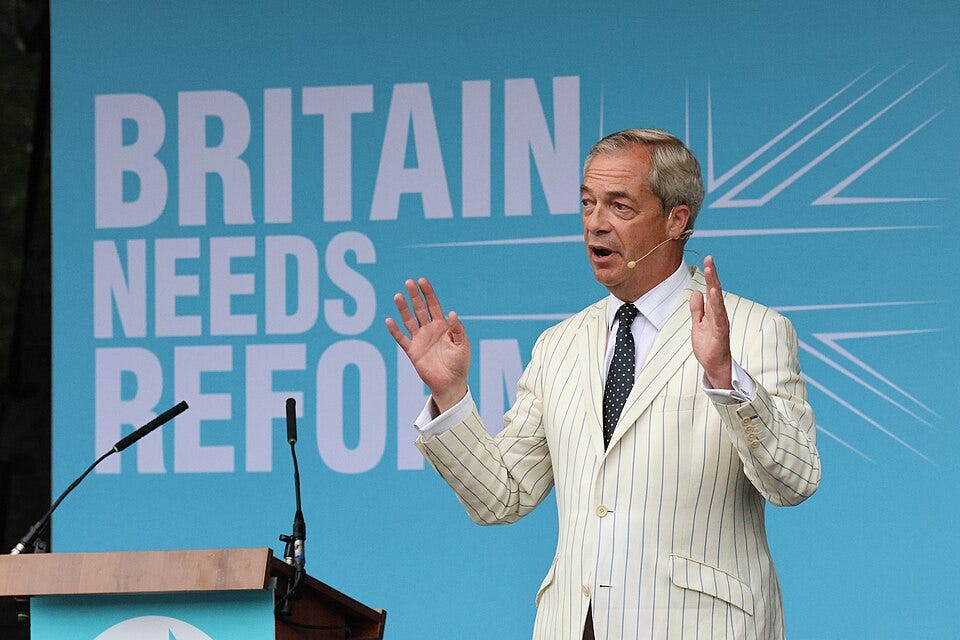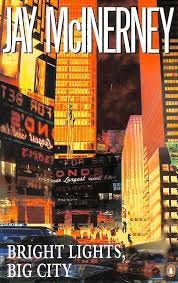The New Yorker: Animal, Mineral or Vegetable?
Also: 'Bright Lights, Big City'; and my conversion to Reform
Mirthless in Manhattan
Review of ‘A Century of The New Yorker’

“Over the past 100 years, The New Yorker has created a world of its own.” So begins the wall blurb for the exhibition ‘A Century of The New Yorker’ at the Stephen A. Schwarzman Building of the New York Public Library:
“Guided by the founding vision of Harold Ross and Jane Grant, and built upon by generations of staff, the magazine has set the bar for effortless style, thought-provoking prose, journalistic rigor, and playful art—delivered with a dash of snootiness, and a wink.”
It’s a shame that so few of these qualities were employed in the writing of these notices. Here’s some more: “In its contributors and its content, the magazine has reflected both the lofty ideals and the profound inequalities that have defined the American experience in ways that continue to shape our social and political landscape today.” How’s that for “effortless style”? Prose this dead should not be on public display. If they hadn’t pinned it to the wall it would be pushing up the daisies.
This stylistic failure betrays a conceptual one. The leaden copy is of a piece with the achingly Respectful tone of the show. The curators have chosen to emphasise the magazine’s status as an American Institution, (with it’s related associations of padded walls, heavy sedatives, and frontal lobotomy), rather than as a house of mirth and wit.
The show in effect says The New Yorker covered events as they occurred, (a claim it has in common with other publications), and, having “reflected the profound inequalities that have defined the American experience” etc., eventually published writers from ethnic and sexual minorities. This seems rather to undersell what was and remains a great magazine.
Despite what must be a treasure-trove of an archive, the curators have made a dull selection — one mediocre piece from Dorothy Parker, (how they managed that, I don’t know), the lamest cartoons, the more forgettable magazine covers.
There are some gems. A letter from JD Salinger in full Holden Caulfield style jumps off the page; Hannah Arendt’s typed manuscript for what became her book Eichmann in Jerusalem (first published as a series in the NY); a letter from Vladimir Nabokov pleading with the magazine to “correct” his grammar but not his style; a handwritten copy of WH Auden’s poem ‘Refugee Blues’; and two readers’ letters —one for and one very racistly against — responding to James Baldwin’s essay ‘Letter from a Region in my Mind’, which would become part of The Fire Next Time. But as you can see, these are all somewhat oblique, and only make you hungry for what they kept in the archives.
The result is a dud show which gives visitors little notion of why anyone might have wanted to read The New Yorker, or what sets it apart from other magazines, then and now. The creative tension between stuffy fact-checking and subversive humour would have been a fruitful place to start.
****
The Review of New York Books #1
A regular feature (probably) without even the faintest justification. Not to be confused with The New York Review of Books.
Between the Lines
Review of ‘Bright Lights, Big City’ by Jay McInerney (1984)
By coincidence, this week I finished reading Bright Lights, Big City, in which Jay McInerney turns his experience at The New Yorker from lead into gold. It doesn’t so much explore the tension I suggest above as embody it.
Some of what was new at the time the book came out in 1984 has lost its ability to shock. Cocaine! Lesbians! The New York Post! Big screen depictions of cocaine use from Goodfellas on down have built up a public tolerance, to the point where Charli xcx can have a mainstream pop smash with “bumpin’ it” as the hook. And all of the literary excess-farces of the 1980s wilt in the shadow of Martin Amis’s Money (1985).
But one sees immediately why the book was a hit. McInerney has a gift for writing no more and no less than he needs. It’s a natural style that which feels economical without being stingy.
He also has a flair for the aphoristic, without it ever sounding like a line has been worked on all night. No later than page three, for example, we read: “You have travelled in the course of the night from the meticulous to the slime.” That’s a turn of phrase worthy of the Algonquin set. How about this, remarking on a model’s physique: “She had too much chest for couture.” This really could be Dorothy Parker, who began her career writing fashion captions for Vogue.
A couple more. Of his boss at the unnamed magazine’s Department of Factual Verification, McInerney’s unnamed narrator writes: “Clara has a mind like a steel mousetrap and a heart like a twelve minute egg.” Or the music of this line, after a quick set up: “You have always thought that Michael would make a great prosecuting attorney. He has an acute sense of universal guilt and a keen nose for circumstantial evidence.” That’s perfectly weighted, and could have been written by HL Mencken.
Beyond the fine lines — which I do think bear the influence of the magazine McInerney escaped — the lines of coke, and the slapstick, we find a story of repressed grief, as the protagonist reveals the cancer-death of his mother. It turns out there’s no quantity of blow that will drown out reality forever.
Near the end of the book, we read our nameless anti-hero suggest that the living “have a responsibility to the dead”, only to turn the page to this: “The first light of the morning outlines the towers of the World Trade Center at the tip of the island.”
It would be 17 years before those towers would be destroyed, along with the people in them, by humourless men who never doubted they were right, and who believed you only need one book, and should only read it literally. (September 11th is the backdrop of McInerney’s 2006 book The Good Life.)
Today the book reminds that the responsibility of the living to the dead can’t easily be evaded by retreat into nihilistic self-destruction — and can’t be faced without an ironic sensibility.
****
Springtime for Nigel

“There’s a turquoise wave heading for the UK, and it should be welcomed with open arms.” That’s a line for my latest column in The Big Issue, which I’m delighted to see some readers have found confusing. The piece is titled: How I Learned to Stop Worrying and Love Reform.
Here’s an excerpt:
“… critics allege that Reform’s self-styled tribunes of the people are such Brechtian caricatures of wealth and privilege, they might as well be wearing top hats and monocles. But this would be the politics of envy. Why begrudge people for making money? What matters is this: Reform UK in power will fight for a Britain where everyone has the right to be born into a wealthy family.”
****
Thank you for subscribing to The Definite Article. Click here to share this edition with your friends (and/or enemies):
The Definite Article is free to read, but who doesn’t like money? Click here to subsidize my writing addiction:





